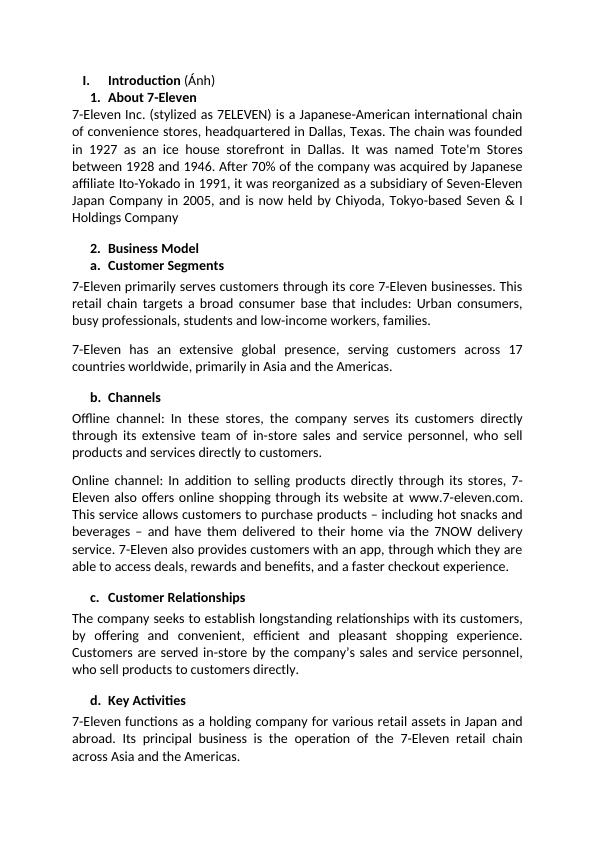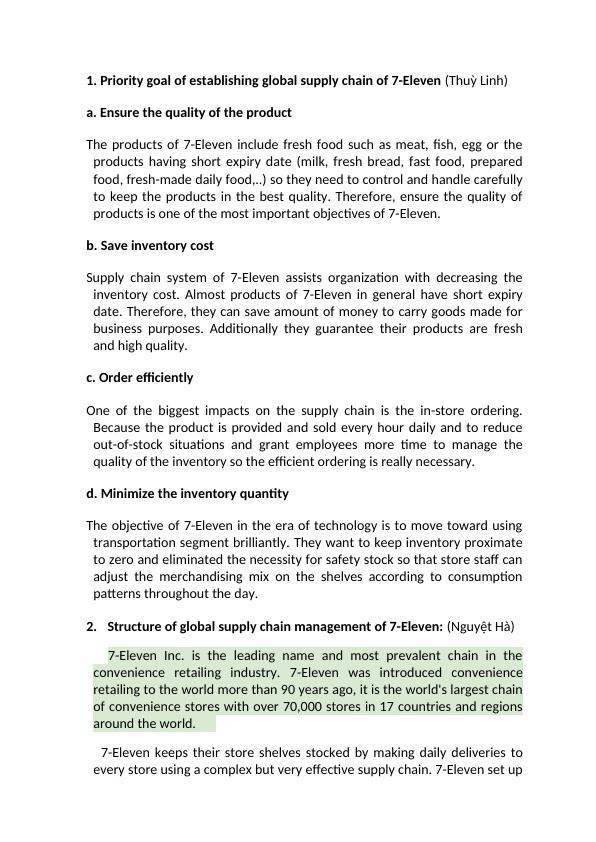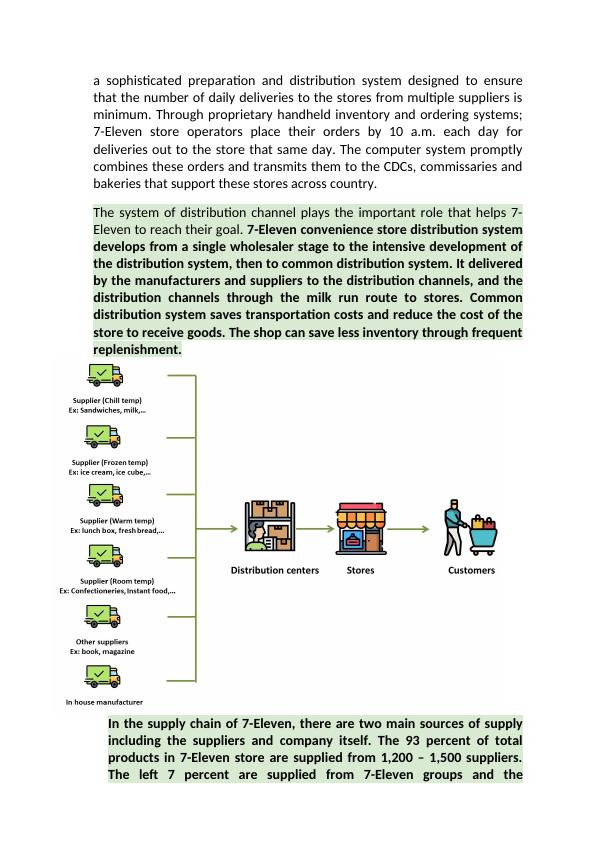Assignment on 7 Eleven PDF
11 Pages4264 Words770 Views
Added on 2021-08-19
Assignment on 7 Eleven PDF
Added on 2021-08-19
ShareRelated Documents
I. Introduction (Ánh)
1. About 7-Eleven
7-Eleven Inc. (stylized as 7ELEVEN) is a Japanese-American international chain
of convenience stores, headquartered in Dallas, Texas. The chain was founded
in 1927 as an ice house storefront in Dallas. It was named Tote'm Stores
between 1928 and 1946. After 70% of the company was acquired by Japanese
affiliate Ito-Yokado in 1991, it was reorganized as a subsidiary of Seven-Eleven
Japan Company in 2005, and is now held by Chiyoda, Tokyo-based Seven & I
Holdings Company
2. Business Model
a. Customer Segments
7-Eleven primarily serves customers through its core 7-Eleven businesses. This
retail chain targets a broad consumer base that includes: Urban consumers,
busy professionals, students and low-income workers, families.
7-Eleven has an extensive global presence, serving customers across 17
countries worldwide, primarily in Asia and the Americas.
b. Channels
Offline channel: In these stores, the company serves its customers directly
through its extensive team of in-store sales and service personnel, who sell
products and services directly to customers.
Online channel: In addition to selling products directly through its stores, 7-
Eleven also offers online shopping through its website at www.7-eleven.com.
This service allows customers to purchase products – including hot snacks and
beverages – and have them delivered to their home via the 7NOW delivery
service. 7-Eleven also provides customers with an app, through which they are
able to access deals, rewards and benefits, and a faster checkout experience.
c. Customer Relationships
The company seeks to establish longstanding relationships with its customers,
by offering and convenient, efficient and pleasant shopping experience.
Customers are served in-store by the company’s sales and service personnel,
who sell products to customers directly.
d. Key Activities
7-Eleven functions as a holding company for various retail assets in Japan and
abroad. Its principal business is the operation of the 7-Eleven retail chain
across Asia and the Americas.
1. About 7-Eleven
7-Eleven Inc. (stylized as 7ELEVEN) is a Japanese-American international chain
of convenience stores, headquartered in Dallas, Texas. The chain was founded
in 1927 as an ice house storefront in Dallas. It was named Tote'm Stores
between 1928 and 1946. After 70% of the company was acquired by Japanese
affiliate Ito-Yokado in 1991, it was reorganized as a subsidiary of Seven-Eleven
Japan Company in 2005, and is now held by Chiyoda, Tokyo-based Seven & I
Holdings Company
2. Business Model
a. Customer Segments
7-Eleven primarily serves customers through its core 7-Eleven businesses. This
retail chain targets a broad consumer base that includes: Urban consumers,
busy professionals, students and low-income workers, families.
7-Eleven has an extensive global presence, serving customers across 17
countries worldwide, primarily in Asia and the Americas.
b. Channels
Offline channel: In these stores, the company serves its customers directly
through its extensive team of in-store sales and service personnel, who sell
products and services directly to customers.
Online channel: In addition to selling products directly through its stores, 7-
Eleven also offers online shopping through its website at www.7-eleven.com.
This service allows customers to purchase products – including hot snacks and
beverages – and have them delivered to their home via the 7NOW delivery
service. 7-Eleven also provides customers with an app, through which they are
able to access deals, rewards and benefits, and a faster checkout experience.
c. Customer Relationships
The company seeks to establish longstanding relationships with its customers,
by offering and convenient, efficient and pleasant shopping experience.
Customers are served in-store by the company’s sales and service personnel,
who sell products to customers directly.
d. Key Activities
7-Eleven functions as a holding company for various retail assets in Japan and
abroad. Its principal business is the operation of the 7-Eleven retail chain
across Asia and the Americas.

7-Eleven organises its operations into seven business segments: the
Convenience Store segment, through which the company operates a large
network of convenience stores under the 7-Eleven brand through direct
operation and franchising; the Super Store segment, through which the
company operates general supermarkets, food supermarkets and specialty
stores; the Department Store segment, through which the company operates
department stores, notably Sogo & Seibu; the Food Service segment, through
which the company is engaged in the restaurant business, the contract food
business and the fast food business; the Financial-related segment, through
which the company is engaged in the banking service, credit card and leasing
business; the Mail Order segment, through which the company is engaged in
the mail order business and the sale of gift products; and the Others segment,
through which the company is engaged in the IT business, and the gasoline
wholesale business.
e. Key Partner
7-Eleven works closely with a broad range of partners in the operation of its
core 7-Eleven business in Japan and overseas.
These partners can be organised broadly into the following categories.
- Supplier and Vendor Partners: comprising the various food companies
and wholesalers that provide food and beverage products and
merchandise that are sold across the company’s 7-Eleven stores, as well
as third-party providers of various other services;
- Franchise Partners: comprising various companies and business owners
that operate 7-Eleven stores on the company’s behalf;
- Distribution and Delivery Partners: comprising various logistics and
distribution companies that assist in the storage and distribution of
products sold across 7-Eleven’s network of stores, as well as delivery
service providers that support the company’s home delivery services;
- Branding and Marketing Partners: comprising various brands,
companies, and organisations that collaborate with 7-Eleven on various
co-branding, marketing, and business development projects; and
- Strategic Partners: comprising a range of companies and organisations
that work with 7-Eleven on various other community, IT, and business
projects.
- In recent years, 7-Eleven has partnered with WD Partners on ways to
update the look and experience of its stores, and with NEC, as part of a
strategic IT partnership for the global 7-Eleven network.
II. Global supply chain management of 7-Eleven
Convenience Store segment, through which the company operates a large
network of convenience stores under the 7-Eleven brand through direct
operation and franchising; the Super Store segment, through which the
company operates general supermarkets, food supermarkets and specialty
stores; the Department Store segment, through which the company operates
department stores, notably Sogo & Seibu; the Food Service segment, through
which the company is engaged in the restaurant business, the contract food
business and the fast food business; the Financial-related segment, through
which the company is engaged in the banking service, credit card and leasing
business; the Mail Order segment, through which the company is engaged in
the mail order business and the sale of gift products; and the Others segment,
through which the company is engaged in the IT business, and the gasoline
wholesale business.
e. Key Partner
7-Eleven works closely with a broad range of partners in the operation of its
core 7-Eleven business in Japan and overseas.
These partners can be organised broadly into the following categories.
- Supplier and Vendor Partners: comprising the various food companies
and wholesalers that provide food and beverage products and
merchandise that are sold across the company’s 7-Eleven stores, as well
as third-party providers of various other services;
- Franchise Partners: comprising various companies and business owners
that operate 7-Eleven stores on the company’s behalf;
- Distribution and Delivery Partners: comprising various logistics and
distribution companies that assist in the storage and distribution of
products sold across 7-Eleven’s network of stores, as well as delivery
service providers that support the company’s home delivery services;
- Branding and Marketing Partners: comprising various brands,
companies, and organisations that collaborate with 7-Eleven on various
co-branding, marketing, and business development projects; and
- Strategic Partners: comprising a range of companies and organisations
that work with 7-Eleven on various other community, IT, and business
projects.
- In recent years, 7-Eleven has partnered with WD Partners on ways to
update the look and experience of its stores, and with NEC, as part of a
strategic IT partnership for the global 7-Eleven network.
II. Global supply chain management of 7-Eleven

1. Priority goal of establishing global supply chain of 7-Eleven (Thuỳ Linh)
a. Ensure the quality of the product
The products of 7-Eleven include fresh food such as meat, fish, egg or the
products having short expiry date (milk, fresh bread, fast food, prepared
food, fresh-made daily food,..) so they need to control and handle carefully
to keep the products in the best quality. Therefore, ensure the quality of
products is one of the most important objectives of 7-Eleven.
b. Save inventory cost
Supply chain system of 7-Eleven assists organization with decreasing the
inventory cost. Almost products of 7-Eleven in general have short expiry
date. Therefore, they can save amount of money to carry goods made for
business purposes. Additionally they guarantee their products are fresh
and high quality.
c. Order efficiently
One of the biggest impacts on the supply chain is the in-store ordering.
Because the product is provided and sold every hour daily and to reduce
out-of-stock situations and grant employees more time to manage the
quality of the inventory so the efficient ordering is really necessary.
d. Minimize the inventory quantity
The objective of 7-Eleven in the era of technology is to move toward using
transportation segment brilliantly. They want to keep inventory proximate
to zero and eliminated the necessity for safety stock so that store staff can
adjust the merchandising mix on the shelves according to consumption
patterns throughout the day.
2. Structure of global supply chain management of 7-Eleven: (Nguyệt Hà)
7-Eleven Inc. is the leading name and most prevalent chain in the
convenience retailing industry. 7-Eleven was introduced convenience
retailing to the world more than 90 years ago, it is the world's largest chain
of convenience stores with over 70,000 stores in 17 countries and regions
around the world.
7-Eleven keeps their store shelves stocked by making daily deliveries to
every store using a complex but very effective supply chain. 7-Eleven set up
a. Ensure the quality of the product
The products of 7-Eleven include fresh food such as meat, fish, egg or the
products having short expiry date (milk, fresh bread, fast food, prepared
food, fresh-made daily food,..) so they need to control and handle carefully
to keep the products in the best quality. Therefore, ensure the quality of
products is one of the most important objectives of 7-Eleven.
b. Save inventory cost
Supply chain system of 7-Eleven assists organization with decreasing the
inventory cost. Almost products of 7-Eleven in general have short expiry
date. Therefore, they can save amount of money to carry goods made for
business purposes. Additionally they guarantee their products are fresh
and high quality.
c. Order efficiently
One of the biggest impacts on the supply chain is the in-store ordering.
Because the product is provided and sold every hour daily and to reduce
out-of-stock situations and grant employees more time to manage the
quality of the inventory so the efficient ordering is really necessary.
d. Minimize the inventory quantity
The objective of 7-Eleven in the era of technology is to move toward using
transportation segment brilliantly. They want to keep inventory proximate
to zero and eliminated the necessity for safety stock so that store staff can
adjust the merchandising mix on the shelves according to consumption
patterns throughout the day.
2. Structure of global supply chain management of 7-Eleven: (Nguyệt Hà)
7-Eleven Inc. is the leading name and most prevalent chain in the
convenience retailing industry. 7-Eleven was introduced convenience
retailing to the world more than 90 years ago, it is the world's largest chain
of convenience stores with over 70,000 stores in 17 countries and regions
around the world.
7-Eleven keeps their store shelves stocked by making daily deliveries to
every store using a complex but very effective supply chain. 7-Eleven set up

a sophisticated preparation and distribution system designed to ensure
that the number of daily deliveries to the stores from multiple suppliers is
minimum. Through proprietary handheld inventory and ordering systems;
7-Eleven store operators place their orders by 10 a.m. each day for
deliveries out to the store that same day. The computer system promptly
combines these orders and transmits them to the CDCs, commissaries and
bakeries that support these stores across country.
The system of distribution channel plays the important role that helps 7-
Eleven to reach their goal. 7-Eleven convenience store distribution system
develops from a single wholesaler stage to the intensive development of
the distribution system, then to common distribution system. It delivered
by the manufacturers and suppliers to the distribution channels, and the
distribution channels through the milk run route to stores. Common
distribution system saves transportation costs and reduce the cost of the
store to receive goods. The shop can save less inventory through frequent
replenishment.
In the supply chain of 7-Eleven, there are two main sources of supply
including the suppliers and company itself. The 93 percent of total
products in 7-Eleven store are supplied from 1,200 – 1,500 suppliers.
The left 7 percent are supplied from 7-Eleven groups and the
that the number of daily deliveries to the stores from multiple suppliers is
minimum. Through proprietary handheld inventory and ordering systems;
7-Eleven store operators place their orders by 10 a.m. each day for
deliveries out to the store that same day. The computer system promptly
combines these orders and transmits them to the CDCs, commissaries and
bakeries that support these stores across country.
The system of distribution channel plays the important role that helps 7-
Eleven to reach their goal. 7-Eleven convenience store distribution system
develops from a single wholesaler stage to the intensive development of
the distribution system, then to common distribution system. It delivered
by the manufacturers and suppliers to the distribution channels, and the
distribution channels through the milk run route to stores. Common
distribution system saves transportation costs and reduce the cost of the
store to receive goods. The shop can save less inventory through frequent
replenishment.
In the supply chain of 7-Eleven, there are two main sources of supply
including the suppliers and company itself. The 93 percent of total
products in 7-Eleven store are supplied from 1,200 – 1,500 suppliers.
The left 7 percent are supplied from 7-Eleven groups and the

End of preview
Want to access all the pages? Upload your documents or become a member.
Related Documents
Expanding 7 Eleven in Brazil: Cultural Elements and Importance of Cultural Literacylg...
|9
|2763
|464
Relevance of Stakeholders in 7-Elevenlg...
|16
|3801
|30
Management Problemlg...
|11
|2850
|418
HI5015: Legal Aspects of International Business and Enterpriselg...
|12
|2486
|159
Consumer Experience Strategy Assignmentlg...
|12
|753
|26
Management of Companies with Unrelated Diversificationlg...
|7
|2581
|585
